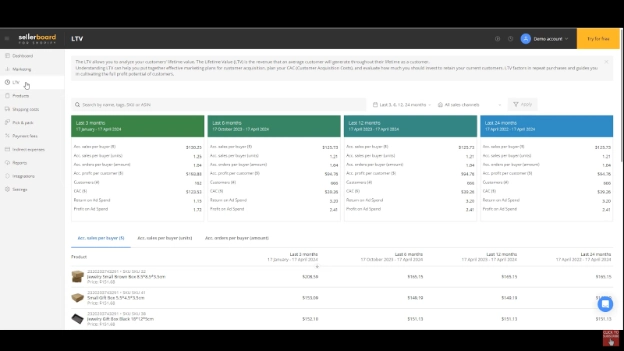Sellerboard For Shopify - Lifetime Value Dashboard Tutorial - Maximize Profits With Repeat Buyers

-
Why the Lifetime Value Dashboard Matters
-
Account-Level vs. Product-Level Analysis
- Account Level
- Product Level
-
Smarter Marketing and Customer Acquisition
-
Planning for Growth with Confidence
-
Final Thoughts
Disclosure: Hi! It's Vova :) Some of the links in this article may be affiliate links. I get a commission if you purchase after clicking on the link, this does not cost you more money, and many times I can even get a nice discount for you. This helps me keep the content free forever. For you. Thank you! :)
If you knew the true worth of your customers, is there anything you'd change in your strategy?
Recently, I had the pleasure of chatting with Alex Speian from Sellerboard on my YouTube channel, and we dove into a topic that every Shopify seller should pay attention to…
It's LTV, or Lifetime Value.
Now, why does LTV matter so much?
In simple terms, LTV shows how much revenue each customer brings in over time.
If you run a business with consumable products, bulk items, or anything people are likely to buy repeatedly, understanding this metric is a game-changer.
And that’s exactly where Sellerboard’s Lifetime Value Dashboard comes in.
Why the Lifetime Value Dashboard Matters
Think about this: if you’re selling products that people need again and again, repeat customers are your goldmine.
If they’re happy with your product and service, chances are they’ll come back often.
Sellerboard’s LTV Dashboard makes it easy to see the accumulated sales per buyer over different time frames.
This means you can analyze, for example, how much the average customer spent on your store in the last 3, 6, 12, or even 24 months.
If you notice that the average customer has spent more than the cost of your product, it’s a clear sign they’re coming back for repeat purchases.
And that insight is honestly so powerful.
===
Want a complete walkthrough of Sellerboard’s features? In this written tutorial I go through every dashboard: Learn How To Use Sellerboard For Shopify: A Full Tutorial
===
Account-Level vs. Product-Level Analysis
So, how does this help you as a seller?
The dashboard lets you analyze data on two levels:
Account Level
This gives you a big-picture view.
Are your customers returning?
Are they spending more over time?
This helps you measure whether your customer experience and retention strategies are actually working.
If your LTV is going up, you’re on the right track.
Product Level
This digs deeper.
You can see which specific products are being bought multiple times by the same customer.
This helps you prioritize which products to promote, especially those that encourage repeat purchases.
Smarter Marketing and Customer Acquisition
Here’s where things get really interesting.
If you’re in a highly competitive market, you may need to sell your first product at little to no profit just to acquire a customer.
Sounds counterintuitive, right?
But here’s the magic:
Once you know your LTV, you can predict how much that customer will spend on future purchases.
That means you can justify spending more on ads or even breaking even on the first sale; because the profit comes from the second, third, or even fourth purchase.
With Sellerboard’s data, you can confidently say, “Okay, I can afford to invest more in advertising for this product because I know customers will come back for more.”
This is how smart businesses scale; by balancing customer acquisition costs with long-term profitability.
Planning for Growth with Confidence
In short, Sellerboard’s LTV Dashboard helps you:
Track accumulated sales per buyer (both in value and units)
Measure profit per customer over time
Identify which products drive repeat business
Plan your ad spend strategically based on long-term returns
When you see which products bring customers back, it becomes much easier to optimize your marketing and plan for growth.
===
Sellerboard isn’t the only tool that can level‑up your Shopify store.
In this post I review Sellerboard alongside Link My Books and explain how these two tools work together to handle analytics and bookkeeping:
Top 2 Best Tools & Software Apps For Shopify Sellers - Sales Analytics, Accounting & Bookkeeping.
===
Final Thoughts
If you’re serious about growing your Shopify store, understanding LTV is a must. Sellerboard’s Lifetime Value Dashboard makes it simple to see the numbers that actually matter.
As Alex Speian explained during our chat, repeat customers reduce your marketing costs and boost profits over time; because you’re not constantly paying to acquire them.
That’s the real power of tracking lifetime value.
So, if you haven’t yet, give the LTV Dashboard a try.
It might just change the way you approach your sales and marketing strategy.
===
Not sure which Sellerboard plan to choose? I’ve broken down every package and explained what’s included (plus how to save by paying annually): Sellerboard Pricing & Price Plans Review.
===
And hey, would you like to see my full conversation with Alex?
Check out the video below from my YouTube channel where we go even deeper into using Sellerboard for Shopify.
-
Why the Lifetime Value Dashboard Matters
-
Account-Level vs. Product-Level Analysis
- Account Level
- Product Level
-
Smarter Marketing and Customer Acquisition
-
Planning for Growth with Confidence
-
Final Thoughts
Disclosure: Hi! It's Vova :) Some of the links in this article may be affiliate links. I get a commission if you purchase after clicking on the link, this does not cost you more money, and many times I can even get a nice discount for you. This helps me keep the content free forever. For you. Thank you! :)



